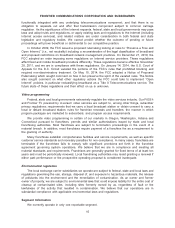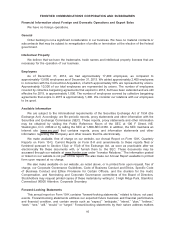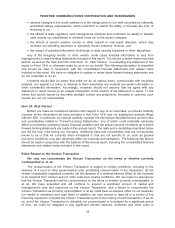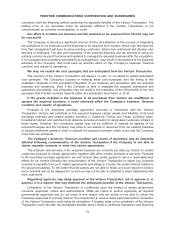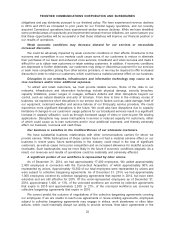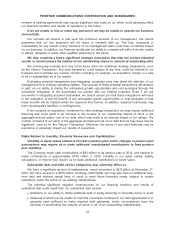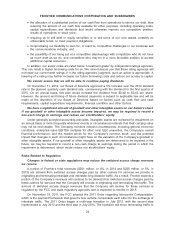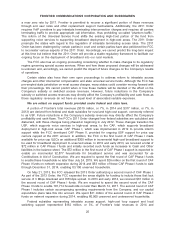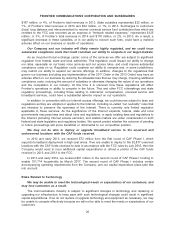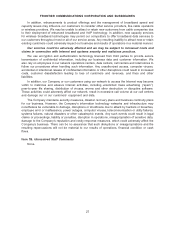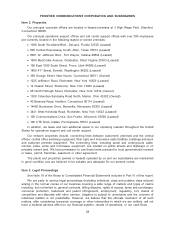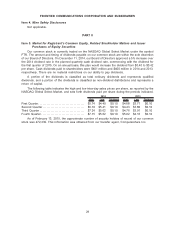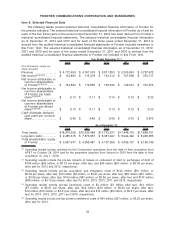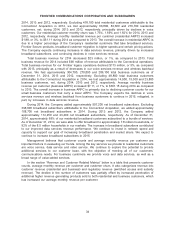Frontier Communications 2014 Annual Report Download - page 26
Download and view the complete annual report
Please find page 26 of the 2014 Frontier Communications annual report below. You can navigate through the pages in the report by either clicking on the pages listed below, or by using the keyword search tool below to find specific information within the annual report.a near zero rate by 2017. Frontier is permitted to recover a significant portion of those revenues
through end user rates and other replacement support mechanisms. Additionally, the 2011 Order
requires VoIP providers to pay interstate terminating interconnection charges and requires all carriers
terminating traffic to provide appropriate call information, thus prohibiting so-called “phantom traffic.”
The reform of the Universal Service Fund shifts the existing High-Cost portion of the fund from
supporting voice services to supporting broadband deployment in high-cost areas. The 2011 Order
preempts the states with regard to the regulation of intrastate terminating access rates. The 2011
Order has been challenged by certain parties in court and certain parties have also petitioned the FCC
to reconsider various aspects of the 2011 Order. Accordingly, we cannot predict the long-term impact
at this time but believe that the 2011 Order will provide a stable regulatory framework to facilitate our
ongoing focus on the deployment of broadband into our rural markets.
The FCC also has an ongoing proceeding considering whether to make changes to its regulatory
regime governing special access services. When and how these proposed changes will be addressed
is unknown and, accordingly, we cannot predict the impact of future changes on the Company’s results
of operations.
Certain states also have their own open proceedings to address reform to intrastate access
charges and other intercarrier compensation and state universal service funds. Although the FCC has
pre-empted state jurisdiction on most access charges, many states could consider moving forward with
their proceedings. We cannot predict when or how these matters will be decided or the effect on the
Company’s subsidy or switched access revenues. However, future reductions in the Company’s
subsidy or switched access revenues may directly affect the Company’s profitability and cash flows as
those regulatory revenues do not have an equal level of associated variable expenses.
We are reliant on support funds provided under federal and state laws.
A portion of Frontier’s total revenues ($319 million, or 7%, in 2014 and $317 million, or 7%, in
2013) are derived from federal and state subsidies for rural and high-cost support, commonly referred
to as USF. Future reductions in the Company’s subsidy revenues may directly affect the Company’s
profitability and cash flows. The FCC’s 2011 Order changed how federal subsidies are calculated and
disbursed, with these changes being phased-in beginning in July 2012. These changes transition the
USF, which supports voice services in high-cost areas, to the CAF, which supports broadband
deployment in high-cost areas. CAF Phase I, which was implemented in 2012 to provide interim
support while the FCC developed CAF Phase II, provided for ongoing USF support for price cap
carriers capped at the 2011 amount. In addition, the FCC in the first round of CAF Phase I made
available for price cap ILECs an additional $300 million in incremental high-cost broadband support to
be used for broadband deployment to unserved areas. In 2012 and early 2013, we received a total of
$72 million in CAF Phase I funds and initially recorded such funds as increases to Cash and Other
liabilities in the balance sheet. The $72 million in the first round of CAF Phase I support is expected to
enable an incremental 92,877 households for broadband service and was accounted for as
Contributions in Aid of Construction. We are required to spend the first round of CAF Phase I funds
to enable these households no later than July 24, 2015. We spent $26 million on the first round of CAF
Phase I funds on network expansion during 2014 and $63 million of these CAF Phase I funds to date
through December 31, 2014, enabling 83,100 unserved households.
On May 21, 2013, the FCC released the 2013 Order authorizing a second round of CAF Phase I.
As part of the 2013 Order, the FCC expanded the areas eligible for funding to include those that lack
service of 3 Mbps download and 768 kbps upload. In 2013 and early 2014, we received $61 million in
the second round of CAF Phase I funds. We are required to spend the second round of the CAF
Phase I funds to enable 101,714 households no later than March 14, 2017. The second round of CAF
Phase I includes certain accompanying spending requirements from the Company, and our capital
expenditure plans take this into account. We spent $31 million of the second round of CAF Phase I
funds on network expansion during 2014, enabling 80,900 unserved and underserved households.
Federal subsidies representing interstate access support, high-cost loop support and local
switching support represented $162 million, or 3%, of Frontier’s total revenues in 2014 and
25
FRONTIER COMMUNICATIONS CORPORATION AND SUBSIDIARIES


